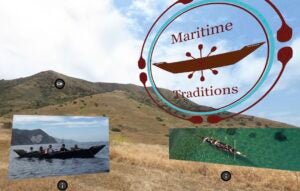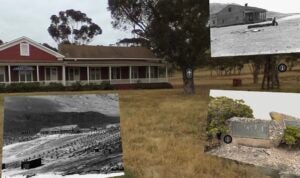Cat Harbor at Catalina Island, California: More Than A Virtual Reality Experience.
By Ariel Gilmore
After taking ARCG 305L Virtual and Digital Culture, Heritage and Archaeology during Maymester 2023, Sawyer Lazar invested time to create a project that takes you on a virtual tour of Catalina Harbor at the isthmus of Catalina island.

Photograph taken inside the VR headset showing the home screen to the Maritime Traditions exhibit.
Over the 2023-2024 school year, Lazar honed the project’s focus to highlight the ways cultural heritage can be preserved and more accessible. During this course, taught by Lynn Swartz Dodd, students had the opportunity to learn methods of heritage documentation, including triangulating positions, mapping, and using submersible cameras which can be used to document shipwrecks and other structures off of Catalina Island. Lazar noticed that “despite the State of California’s robust environmental compliance system, the State’s Cultural Heritage Resources Information System (CHRIS) overlooks submerged sites and wrecks” The State Lands Commission database does not seem to have the same level of detail for wrecks and submerged sites. This is troubling because underwater sites are significant, telling us a great deal about the first settlers who arrived more than 10,000 years ago and revealing the maritime trade, transport and lifeways that supported people ever since then and, eventually, led California to be the state it is today.
In consideration of this oversight, Lazar started to strategize the creation of a State of California District Report for Catalina Harbor’s land and underwater cultural resources. This includes the large shipwreck, the “Palmyra”, which was sunk after being used in an early silent film by Hollywood great Harold Lloyd. According to Lazar, “no coordinated documentation or District Report yet exists for the land and submerged sites around Cat Harbor. Lazar confirmed this when he visited the office in Fullerton, CA where part of California’s cultural heritage records are kept. He did a thorough search and said that he “looks forward to integrating maritime heritage into existing state systems”. Lazar decided to start by using images of the Palmyra wreck taken on land, because the ship’s remains can be seen peeking up through the water’s surface at low tide. He integrated existing historical records and photographs into a 3D 360 immersive experience that can be used in a headset. If you are interested in knowing more or trying the experience in your own headset, send an email to archaeology@usc.edu. Lazar’s work transforms archival images, live interviews, and other materials that were gathered or recorded by Lazar and his classmates during the USC Maymester course into an immersive virtual reality exhibit so that cultural heritage sites that typically are inaccessible to the general public become accessible in a sustainable non-invasive manner.

Photograph taken inside the VR headset showing the Civil War era barracks that still stand near Cat Habor and historic photographs of the island.
Lazar recognizes that “major efforts are needed to document and preserve unique cultural resources of the State of California. This is an urgent need made more challenging by coastal erosion, sea level rise, and the accessibility of sites and wrecks through the use of SCUBA and other underwater technology.” Lazar “aims to contribute to the preservation and appreciation of California’s cultural resources, charting new waters in heritage documentation and inspiring others to follow suit.”
Throughout this experience, Lazar has gained new skills in tailoring archaeological experiences for a new medium, virtual reality, and he hopes to continue working at Catalina Harbor as an American Academy of Underwater Sciences authorized Scientific Diver. USC students can gain this training and learn to document sites and wrecks that lie in the ocean and freshwater places in California and worldwide.